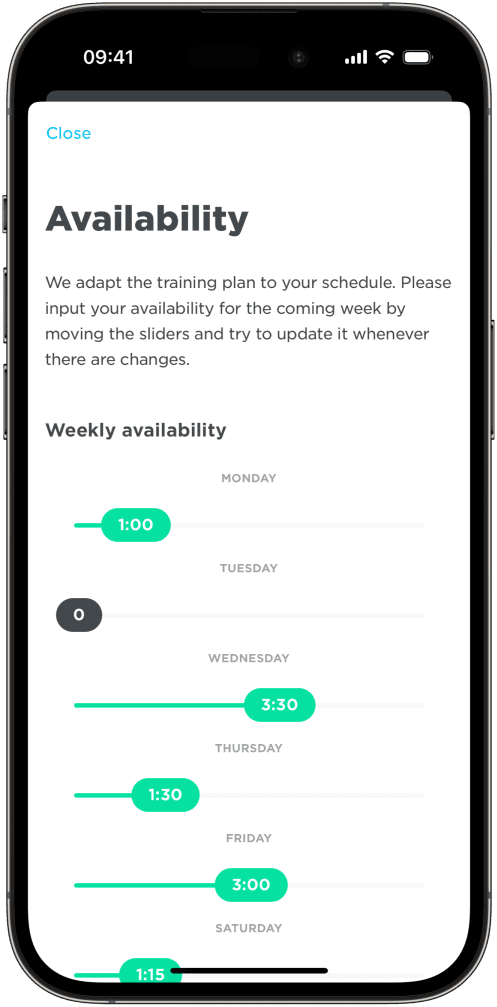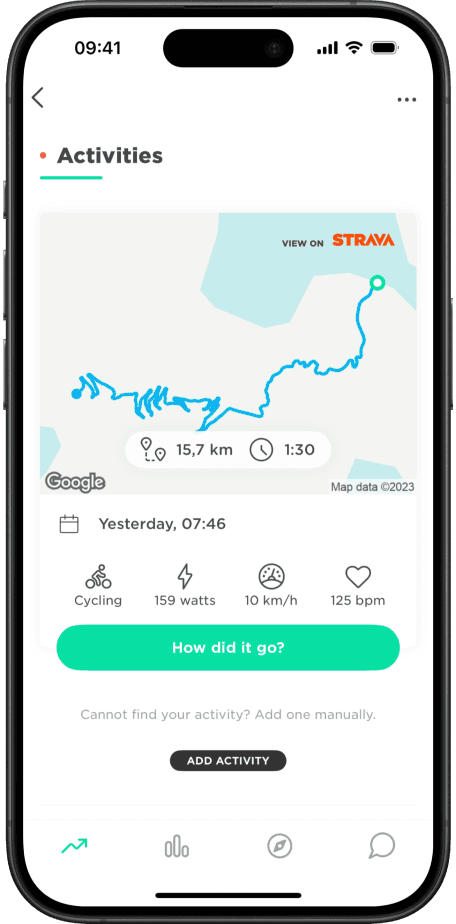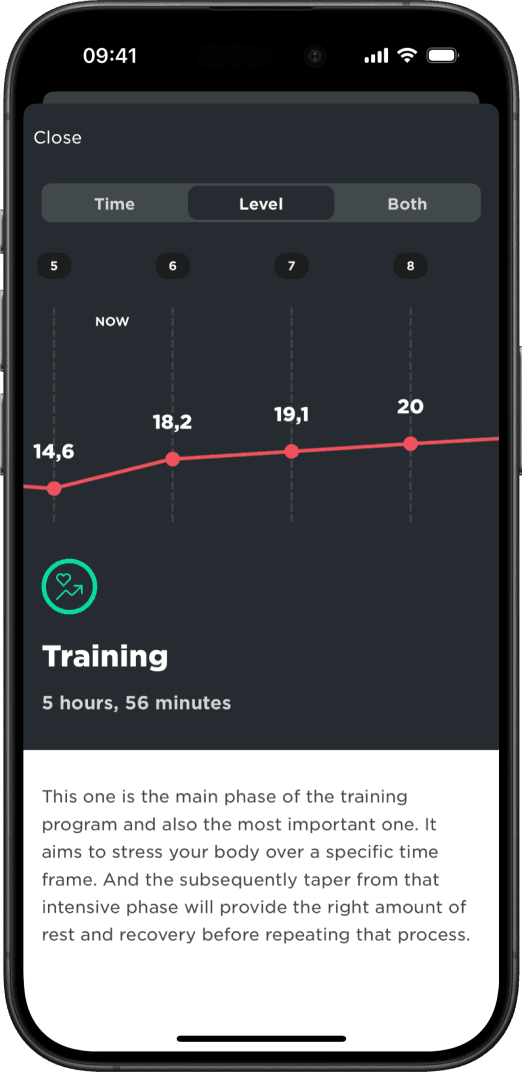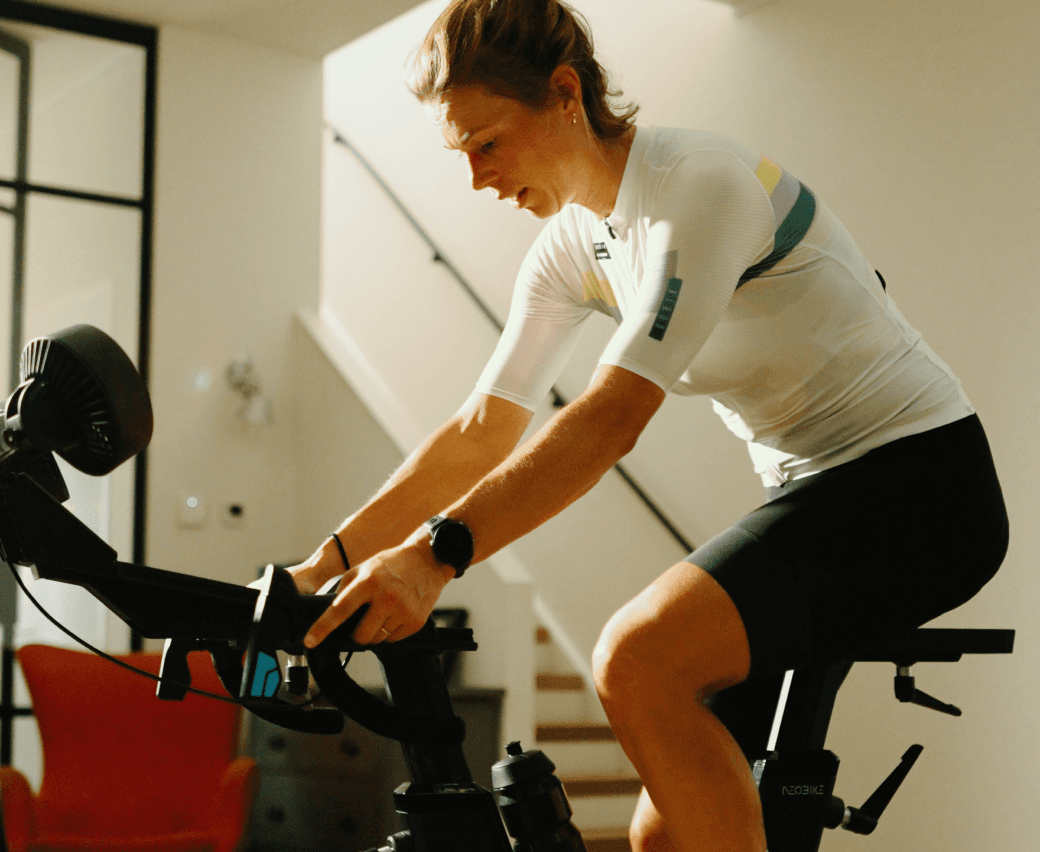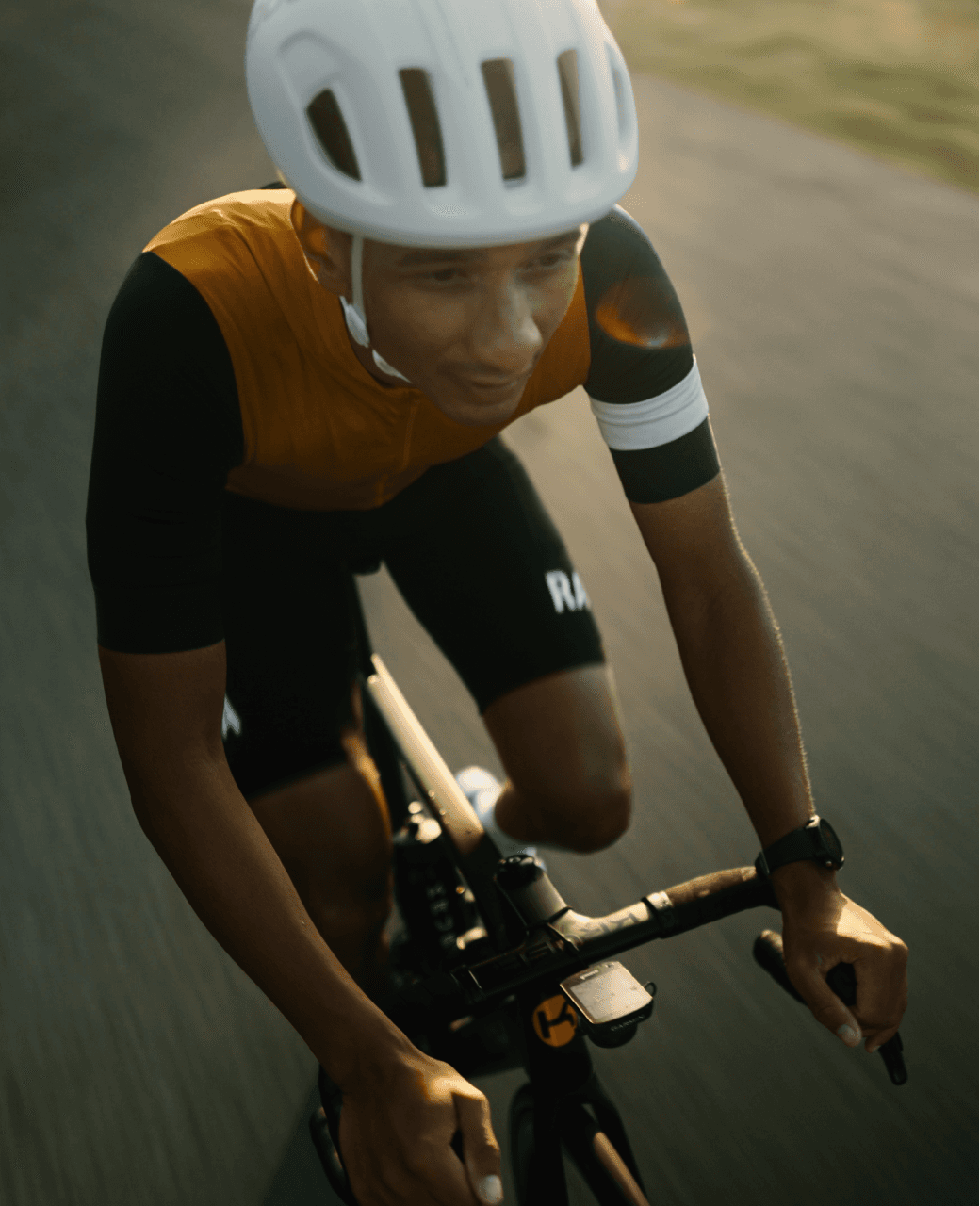The #1 AI Cycling Training Tool
Train smarter with adaptive plans and efficient workouts. Maximize progress, avoid overtraining, and seamlessly connect with favorite apps and devices. Perfect for cyclists of all levels.

The #1 AI Cycling Training Tool
Train smarter with adaptive plans and efficient workouts. Maximize progress, avoid overtraining, and seamlessly connect with favorite apps and devices. Perfect for cyclists of all levels.
The #1 AI Cycling Training Tool
Train smarter with adaptive plans and efficient workouts. Maximize progress, avoid overtraining, and seamlessly connect with favorite apps and devices. Perfect for cyclists of all levels.
The #1 AI Cycling Training Tool
Train smarter with adaptive plans and efficient workouts. Maximize progress, avoid overtraining, and seamlessly connect with favorite apps and devices. Perfect for cyclists of all levels.
Loved by thousands
Excellent app, nice look and feel, easy to use, integrates easily to different third parties and provides great (dynamic) training schedules built to your needs.
Yorick
Great app to train alongside a busy lifestyle. Very easy to use and lots of variety of sessions, integrates seamlessly with Strava etc. Highly recommended!
George
Great app. It does the thinking and planning for me. I just need to update my availability and the app plans the type of training for the time I have available.
Kerry
Very handy app. You can enter and adjust days and hours and it calculates new workouts. The proposed workouts are also very varied. I certainly have a good feeling about it.
Luc
It's a great training app that has motivated me. I love the way it adapts the training plan based on non planned workouts such as club spins.
Barry
Excellent app, nice look and feel, easy to use, integrates easily to different third parties and provides great (dynamic) training schedules built to your needs.
Yorick
Great app to train alongside a busy lifestyle. Very easy to use and lots of variety of sessions, integrates seamlessly with Strava etc. Highly recommended!
George
Great app. It does the thinking and planning for me. I just need to update my availability and the app plans the type of training for the time I have available.
Kerry
Very handy app. You can enter and adjust days and hours and it calculates new workouts. The proposed workouts are also very varied. I certainly have a good feeling about it.
Luc
It's a great training app that has motivated me. I love the way it adapts the training plan based on non planned workouts such as club spins.
Barry
Excellent app, nice look and feel, easy to use, integrates easily to different third parties and provides great (dynamic) training schedules built to your needs.
Yorick
Great app to train alongside a busy lifestyle. Very easy to use and lots of variety of sessions, integrates seamlessly with Strava etc. Highly recommended!
George
Great app. It does the thinking and planning for me. I just need to update my availability and the app plans the type of training for the time I have available.
Kerry
Very handy app. You can enter and adjust days and hours and it calculates new workouts. The proposed workouts are also very varied. I certainly have a good feeling about it.
Luc
It's a great training app that has motivated me. I love the way it adapts the training plan based on non planned workouts such as club spins.
Barry
Excellent app, nice look and feel, easy to use, integrates easily to different third parties and provides great (dynamic) training schedules built to your needs.
Yorick
Great app to train alongside a busy lifestyle. Very easy to use and lots of variety of sessions, integrates seamlessly with Strava etc. Highly recommended!
George
Great app. It does the thinking and planning for me. I just need to update my availability and the app plans the type of training for the time I have available.
Kerry
Very handy app. You can enter and adjust days and hours and it calculates new workouts. The proposed workouts are also very varied. I certainly have a good feeling about it.
Luc
It's a great training app that has motivated me. I love the way it adapts the training plan based on non planned workouts such as club spins.
Barry
Loved by thousands
Excellent app, nice look and feel, easy to use, integrates easily to different third parties and provides great (dynamic) training schedules built to your needs.
Yorick
Great app to train alongside a busy lifestyle. Very easy to use and lots of variety of sessions, integrates seamlessly with Strava etc. Highly recommended!
George
Great app. It does the thinking and planning for me. I just need to update my availability and the app plans the type of training for the time I have available.
Kerry
Very handy app. You can enter and adjust days and hours and it calculates new workouts. The proposed workouts are also very varied. I certainly have a good feeling about it.
Luc
It's a great training app that has motivated me. I love the way it adapts the training plan based on non planned workouts such as club spins.
Barry
Excellent app, nice look and feel, easy to use, integrates easily to different third parties and provides great (dynamic) training schedules built to your needs.
Yorick
Great app to train alongside a busy lifestyle. Very easy to use and lots of variety of sessions, integrates seamlessly with Strava etc. Highly recommended!
George
Great app. It does the thinking and planning for me. I just need to update my availability and the app plans the type of training for the time I have available.
Kerry
Very handy app. You can enter and adjust days and hours and it calculates new workouts. The proposed workouts are also very varied. I certainly have a good feeling about it.
Luc
It's a great training app that has motivated me. I love the way it adapts the training plan based on non planned workouts such as club spins.
Barry
Excellent app, nice look and feel, easy to use, integrates easily to different third parties and provides great (dynamic) training schedules built to your needs.
Yorick
Great app to train alongside a busy lifestyle. Very easy to use and lots of variety of sessions, integrates seamlessly with Strava etc. Highly recommended!
George
Great app. It does the thinking and planning for me. I just need to update my availability and the app plans the type of training for the time I have available.
Kerry
Very handy app. You can enter and adjust days and hours and it calculates new workouts. The proposed workouts are also very varied. I certainly have a good feeling about it.
Luc
It's a great training app that has motivated me. I love the way it adapts the training plan based on non planned workouts such as club spins.
Barry
Excellent app, nice look and feel, easy to use, integrates easily to different third parties and provides great (dynamic) training schedules built to your needs.
Yorick
Great app to train alongside a busy lifestyle. Very easy to use and lots of variety of sessions, integrates seamlessly with Strava etc. Highly recommended!
George
Great app. It does the thinking and planning for me. I just need to update my availability and the app plans the type of training for the time I have available.
Kerry
Very handy app. You can enter and adjust days and hours and it calculates new workouts. The proposed workouts are also very varied. I certainly have a good feeling about it.
Luc
It's a great training app that has motivated me. I love the way it adapts the training plan based on non planned workouts such as club spins.
Barry
Excellent app, nice look and feel, easy to use, integrates easily to different third parties and provides great (dynamic) training schedules built to your needs.
Yorick
Great app to train alongside a busy lifestyle. Very easy to use and lots of variety of sessions, integrates seamlessly with Strava etc. Highly recommended!
George
Great app. It does the thinking and planning for me. I just need to update my availability and the app plans the type of training for the time I have available.
Kerry
Very handy app. You can enter and adjust days and hours and it calculates new workouts. The proposed workouts are also very varied. I certainly have a good feeling about it.
Luc
It's a great training app that has motivated me. I love the way it adapts the training plan based on non planned workouts such as club spins.
Barry
Excellent app, nice look and feel, easy to use, integrates easily to different third parties and provides great (dynamic) training schedules built to your needs.
Yorick
Great app to train alongside a busy lifestyle. Very easy to use and lots of variety of sessions, integrates seamlessly with Strava etc. Highly recommended!
George
Great app. It does the thinking and planning for me. I just need to update my availability and the app plans the type of training for the time I have available.
Kerry
Very handy app. You can enter and adjust days and hours and it calculates new workouts. The proposed workouts are also very varied. I certainly have a good feeling about it.
Luc
It's a great training app that has motivated me. I love the way it adapts the training plan based on non planned workouts such as club spins.
Barry
Excellent app, nice look and feel, easy to use, integrates easily to different third parties and provides great (dynamic) training schedules built to your needs.
Yorick
Great app to train alongside a busy lifestyle. Very easy to use and lots of variety of sessions, integrates seamlessly with Strava etc. Highly recommended!
George
Great app. It does the thinking and planning for me. I just need to update my availability and the app plans the type of training for the time I have available.
Kerry
Very handy app. You can enter and adjust days and hours and it calculates new workouts. The proposed workouts are also very varied. I certainly have a good feeling about it.
Luc
It's a great training app that has motivated me. I love the way it adapts the training plan based on non planned workouts such as club spins.
Barry
Excellent app, nice look and feel, easy to use, integrates easily to different third parties and provides great (dynamic) training schedules built to your needs.
Yorick
Great app to train alongside a busy lifestyle. Very easy to use and lots of variety of sessions, integrates seamlessly with Strava etc. Highly recommended!
George
Great app. It does the thinking and planning for me. I just need to update my availability and the app plans the type of training for the time I have available.
Kerry
Very handy app. You can enter and adjust days and hours and it calculates new workouts. The proposed workouts are also very varied. I certainly have a good feeling about it.
Luc
It's a great training app that has motivated me. I love the way it adapts the training plan based on non planned workouts such as club spins.
Barry
Master Your Rides
JOIN tackles common cycling challenges. The dynamic and adaptive training plans help you improve wherever you are at on your journey.
Balancing Training on a Busy Schedule
Plans that adjusting to your availability and progress. Whether it's a workout or a rest day.
Simplicity in Your Training
Simplifies your journey with intuitive, easy-to-follow plans to efficiently reach cycling goals.
Measurable Progress
Seamless integrations for performance tracking, ensuring you see and feel real improvement.
Maintaining Motivation and Consistency
Keeps you inspired with tailored workouts, continuous guidance, and prevents overtraining.
Master Your Rides
JOIN tackles common cycling challenges. The dynamic and adaptive training plans help you improve wherever you are at on your journey.
Balancing Training on a Busy Schedule
Plans that adjusting to your availability and progress. Whether it's a workout or a rest day.
Simplicity in Your Training
Simplifies your journey with intuitive, easy-to-follow plans to efficiently reach cycling goals.
Measurable Progress
Seamless integrations for performance tracking, ensuring you see and feel real improvement.
Maintaining Motivation and Consistency
Keeps you inspired with tailored workouts, continuous guidance, and prevents overtraining.
Master Your Rides
JOIN tackles common cycling challenges. The dynamic and adaptive training plans help you improve wherever you are at on your journey.

Balancing Training on a Busy Schedule

Simplicity in Your Training

Measurable Progress
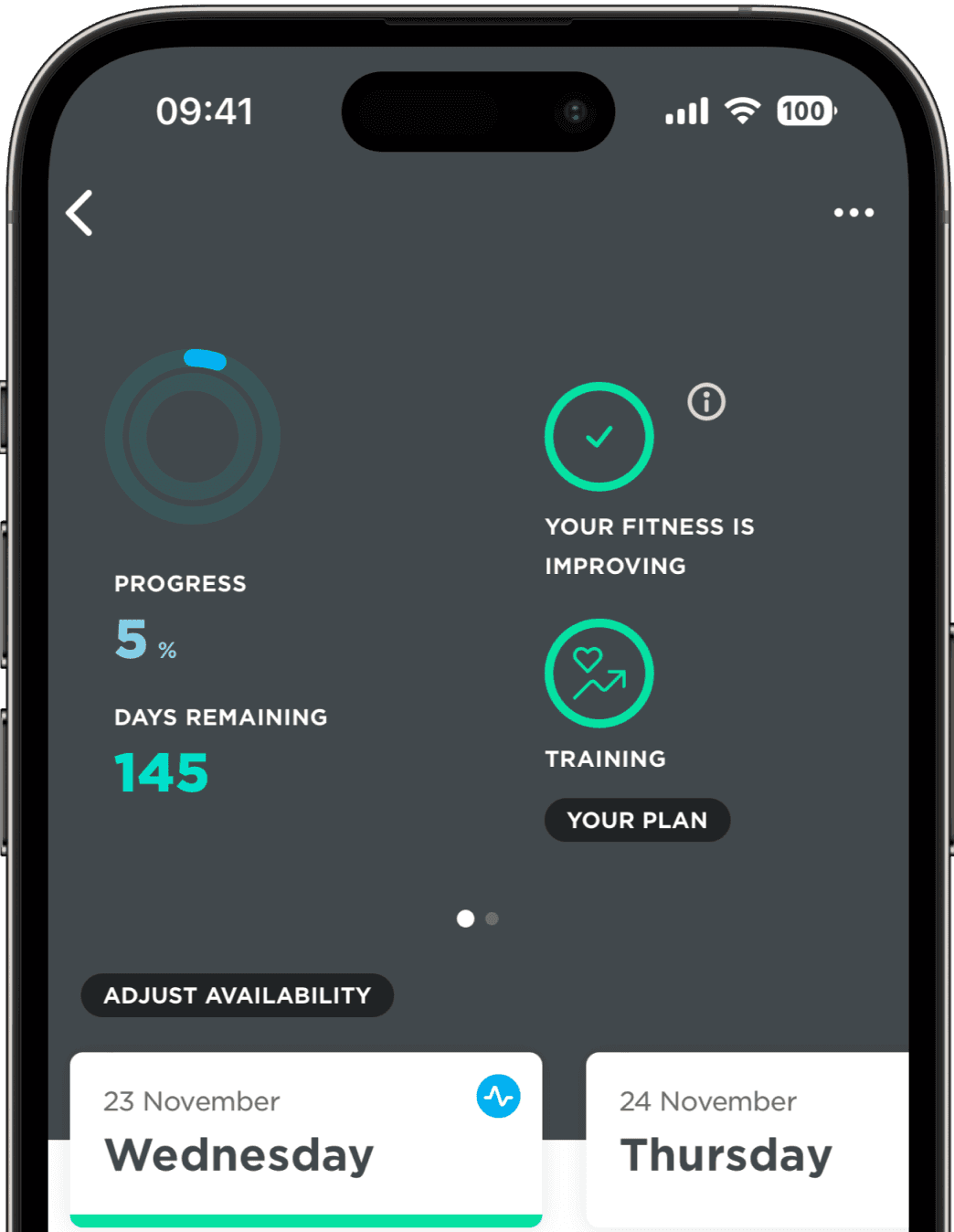
Maintaining Motivation and Consistency

Balancing Training on a Busy Schedule

Simplicity in Your Training

Measurable Progress

Maintaining Motivation and Consistency

Balancing Training on a Busy Schedule

Simplicity in Your Training

Measurable Progress

Maintaining Motivation and Consistency

Balancing Training on a Busy Schedule

Simplicity in Your Training

Measurable Progress

Maintaining Motivation and Consistency
Don't just take our word for it
Don't just take our word for it
Don't just take our word for it
Ride Smarter, Go Further

Start Achieving Your Cycling Goals Today
Join now and experience the power of our dynamic training plans.
A dedicated training plan for everyone
Choose from a big variety of training plans to confidently work toward your own set goal.
A dedicated training plan for everyone
Choose from a big variety of training plans to confidently work toward your own set goal.
A dedicated training plan for everyone
Choose from a big variety of training plans to confidently work toward your own set goal.

Empowering
Science-based Approach
Our users see major performance gains and achieve their goals. Join us and be ready for any ride.
14
Watt FTP improvement in the first 3 months
24%
Level improvement in the first 3 months
82.4%
Users reached their cycling goal

Empowering
Science-based Approach
Our users see major performance gains and achieve their goals. Join us and be ready for any ride.
14
Watt FTP improvement in the first 3 months
24%
Level improvement in the first 3 months
82.4%
Users reached their cycling goal

Empowering
Science-based Approach
Our users see major performance gains and achieve their goals. Join us and be ready for any ride.
14
Watt FTP improvement in the first 3 months
24%
Level improvement in the first 3 months
82.4%
Users reached their cycling goal
Subscribe to JOIN's Newsletter
Stay updated with the latest cycling tips, news, and events.
By joining, you agree to our Terms and Conditions and our Privacy Policy.
Subscribe to JOIN's Newsletter
Stay updated with the latest cycling tips, news, and events.
By joining, you agree to our Terms and Conditions and our Privacy Policy.
Subscribe to JOIN's Newsletter
Stay updated with the latest cycling tips, news, and events.
By joining, you agree to our Terms and Conditions and our Privacy Policy.
Trusted by partners around the globe
Trusted by partners around the globe
Trusted by partners around the globe
FAQs
Find answers to common questions about using JOIN to train for major cycling events.
How does JOIN work?
JOIN creates personalized, adaptive training plans for cyclists based on their fitness level, goals, and availability. The app continuously adjusts your plan to keep you on track, offering structured workouts and insights to help you improve.
What are the benefits?
How do I get started?
Is JOIN suitable for all levels?
Do I need a power meter to use JOIN?
FAQs
Find answers to common questions about using JOIN to train for major cycling events.
How does JOIN work?
JOIN creates personalized, adaptive training plans for cyclists based on their fitness level, goals, and availability. The app continuously adjusts your plan to keep you on track, offering structured workouts and insights to help you improve.
What are the benefits?
How do I get started?
Is JOIN suitable for all levels?
Do I need a power meter to use JOIN?
FAQs
Find answers to common questions about using JOIN to train for major cycling events.
How does JOIN work?
JOIN creates personalized, adaptive training plans for cyclists based on their fitness level, goals, and availability. The app continuously adjusts your plan to keep you on track, offering structured workouts and insights to help you improve.
What are the benefits?
How do I get started?
Is JOIN suitable for all levels?
Do I need a power meter to use JOIN?

